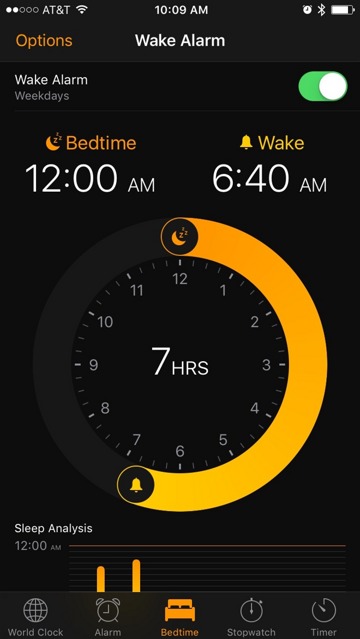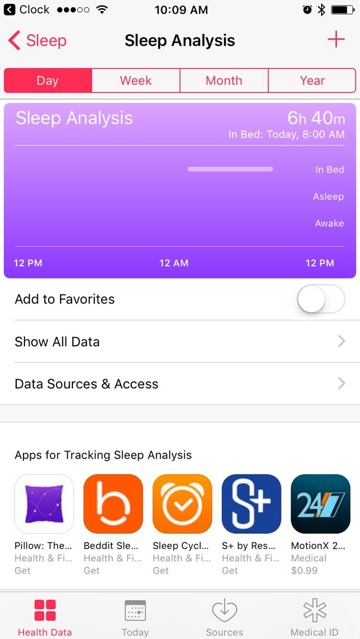As part of a greater focus on user health, Apple has introduced new alarms in iOS 10 for sleep, reminding users when to go to bed for a full night of rest, and also keeping track of their sleeping habits.
The new bedtime and wake alarms are found and configured in the native Clock app in iOS 10, within an all-new "Bedtime" tab. The app notes that going to bed and waking up at the same times every day are key to healthy sleep.
Apple offers users a simplified setup process, asking a series of questions to configure the "Bedtime Alarm" and "Wake Alarm" to their liking. These include what time the user would like to wake up, which days of the week the alarm should go off, and how many hours of sleep they need per night.
After initial setup, the "Bedtime" tab presents a graphical dial to allow users to adjust how much sleep they need per night.
Once configured, users will receive a bedtime reminder the night before alarms are set to go off. This can be customized with a prompt immediately at bedtime, or a range of times up to an hour before a user wants to be in bed.
By prompting a user for bedtime and also waking them up in the morning, the new Bedtime Alarm and Wake Alarm integrate with Apple's Health app, allowing for sleep tracking data. Within the Clock app is a quick link to the "Sleep Analysis" data logged in HealthKit.
The Clock app also offers a visual representation of the user's "Sleep History," challenging them to keep the bars aligned by going to bed and waking up at the same times every day.
Another noteworthy feature is a customizable "Wake Up Sound Volume" within the "Wake Alarm" options. Here, users can customize how loud their alarm is in the morning, separately from the iOS-wide alarm volume.
Editor's note: This article was originally published in June following Apple's announcement of iOS 10 at WWDC 2016. It has been updated and republished to coincide with the mobile operating system's public release. For more on iOS 10, see AppleInsider's ongoing Inside iOS 10.
 Neil Hughes
Neil Hughes












-m.jpg)






 Marko Zivkovic
Marko Zivkovic
 Christine McKee
Christine McKee
 Andrew Orr
Andrew Orr
 Andrew O'Hara
Andrew O'Hara
 William Gallagher
William Gallagher

 Mike Wuerthele
Mike Wuerthele
 Bon Adamson
Bon Adamson




-m.jpg)



28 Comments
Apple's solution for sleep tracking is incomplete. Their device for full sleep tracking is the Apple Watch. But with the current model at around 18 hours you are left with the problem of when to charge it. Charge it during waking hours and you will miss out on its usefulness as notification/quick replier/step tracker/heart rate tracker or charge it during sleep and miss out on complete sleep monitoring.
I sleep with my Apple Watch. I charge it either in the morning or evening depending on how much I've used it - if I do my typical developer 'sit-at-a-keyboard' all day with no workouts, my SS 42mm lasts around 30 hours.
I'm glad that Apple is giving this major health issue the attention it deserves. As others have stated the current Apple Watch is not the ideal device for collecting sleep data. I'm thinking that Apple could develop a smart "Apple Nightstand" that comes with a very thin and lightweight "data acquisition band" (DAQ band) that you'd swap out with your Apple Watch while using the Nightstand to charge both devices. At bedtime you'd take the DAQ band off the Nightstand and place on your wrist (or ankle for restless leg syndrome detection) and place your Apple Watch on the Nightstand where it would charge the watch. When you wake up you'd reverse the process, DAQ band goes on the Nightstand and Apple Watch goes on your wrist. Perhaps the two devices are connected via Bluetooth 4/5 and the Nightstand has a WiFi connection to push your sleep data into the cloud via HealthKit. Maybe the Nightstand is also a HealthKit data collection hub for other health related data collection.